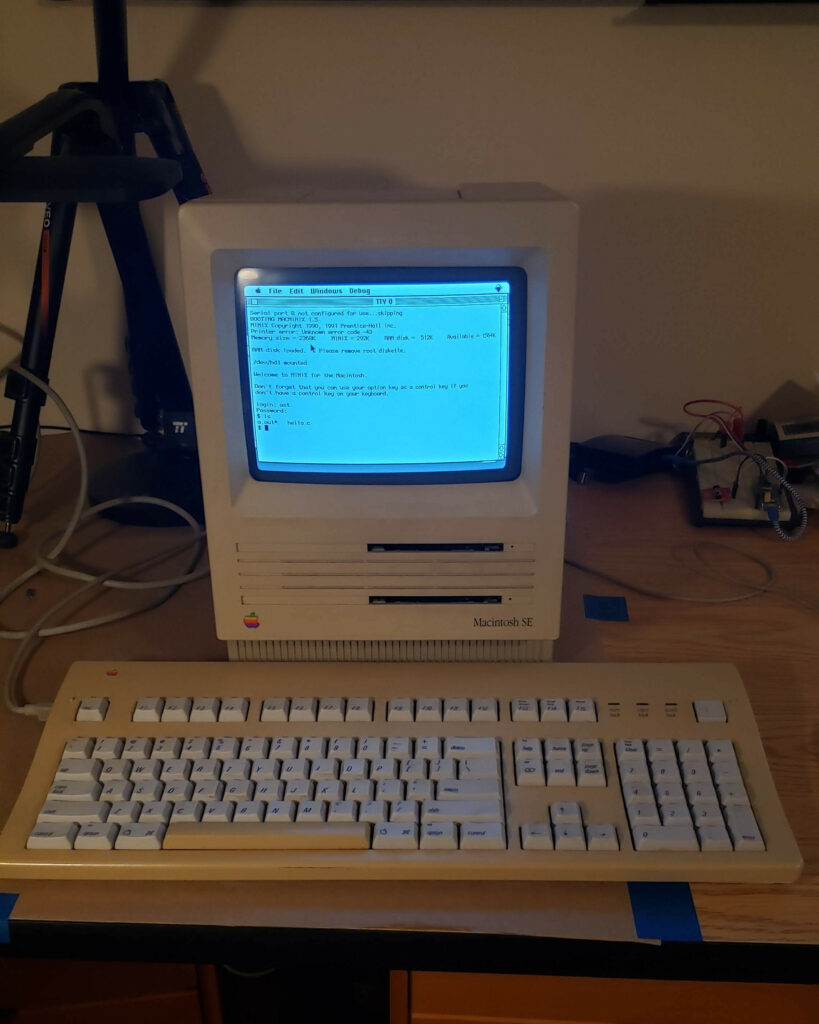Source: loriemerson
Article note: As someone who is currently almost $100 in to my "I want one of the mid-90s ThinkPads with perfect OpenStep/Rhapsody support that were the missing link between Apple-Apple and NeXT-bought-Apple-with-Apple's-own-money-Apple" project, just because I want the experience, this speaks to me.
I love the section about the non-hierarchical lab, even as I roll my eyes at it. The lab I work in has a truly unusual amount of that for the discipline, but the reality is there are always power dynamics around the purse strings and cultural dynamics that invite certain people and ideas, etc.
There's also the usual-for-Lori's-pieces thick layer of Humanities jargon in here - I often imagine trying to use her pieces with CS/EcE students and grimace at their (in)ability to handle the language.
Thanks to the hard work of co-editors Patrick Ellison and Collin Williamson, a special issue of Early Popular Visual Culture is now out – “Object Lessons, Old and New: Experimental Media Archaeology in the Classroom.” Below is the final draft of the Afterword I wrote, in which I outline six opportunities provided by hands-on practice, particularly in the context of media archaeology.
***
The essays in this special issue offer us compelling and inventive pedagogical strategies for effectively transporting artefacts and technological media from the past to the present and even for transporting our experiences of contemporary media from the present to (the recreation of) a possible experience in the past. In short, these strategies are relevant for any scholar working with technological media in a historical register from within any field and any time period. From Meredith Bak’s details of her playful media archaeological experimentations with optical toys in the classroom to Peter J. Bloom’s delving into the vectors of meaning that emerge from juxtapositions of media artefacts in collections, Cristina Corfield’s account of paper-based reconstructions of optical devices, Robby Gilbert’s narrative about how he reveals the mechanisms behind the illusion of movement by excavating basic principles of movement and time in the zoetrope, and Gert Jan Harkema and André Rosendaal’s argument for the importance of classroom activities that rely on touch via Virtual Reality as a way to teach film, all provide us with ways to give students or, broadly speaking, users an alternate access point to history other than through more well-worn methods of narrativization via text or images.
Also implied in all these pieces, and sometimes stated explicitly, is an argument not just for teaching as integral to – if not an extension of – research and creative practice but also for the longstanding importance of hands-on work to the entire ecosystem of higher education. Hands-on work generates insights for research and facilitates teaching and learning for both instructor and student. In fact, the benefits of hands-on work are so clear that one cannot help but wonder how it is that higher education, which has had scientific laboratories in its midst for nearly two hundred years, continues to allot only a relatively small number of disciplines the space and infrastructure for hands-on work. No doubt part of the reason why the arts and humanities must continue to argue for the importance of doing materially grounded and embodied teaching and research comes from these disciplines’ longstanding identification with the practice of hermeneutics and close reading, both of which have, rightly or wrongly, come to be seen as agnostic to medium and materiality. Perhaps another reason is the still-lingering perception of the gulf that exists between ‘the two cultures’; in other words, it is possible that the perceived divide between the arts/humanities on the one hand and the sciences on the other has not been so much about, as C.P. Snow famously put it in 1959, the different cultures of each, but about the perception that some disciplines ‘practice’ while others theorize (Snow 2014). Whatever the reason for the mischaracterization of what the two cultures do, media archaeology has been enormously helpful for the legitimacy it has lent to hands-on practice in the arts/humanities by consistently arguing over the last twenty or thirty years for the possibility, if not the necessity, of moving away from hermeneutics and for the related possibility of attending (sometimes relentlessly) to the material layers of technological media.
The contributors to this special issue similarly side-step debates about the two cultures altogether by advocating for, and thereby legitimizing, the ways in which hands-on teaching and research provide us with opportunities for: 1) open-ended play, 2) experimentation with non-hierarchical relationship structures, 3) exploration of the ergonomics of historical media, 4) embracing, leveraging, and critiquing nostalgia, 5) reimagining the future by way of the past, and 6) disrupting the aura of old technologies. As I point out above, what is also striking to me about the foregoing list of opportunities afforded by hands-on work is that, despite the ways in which technological media are functionally and materially distinct, the techniques for such work are largely consistent across time periods and disciplines. The contributors are from disciplines as diverse as childhood studies, film, media studies, visual arts and education, and their objects of study range from optical playthings to peepshow boxes, zoetropes and cinematographs. I myself have a background in literary studies and the objects I concern myself with in both my research and in hands-on classroom activities range from typewriters to early telecommunications networks and personal computers. Yet, as I expand on below, in my work directing the Media Archaeology Lab at the University of Colorado at Boulder for the last ten years, I too have compiled a list of opportunities afforded by hands-on practice in a lab-like environment nearly identical to those opportunities described by the contributors to this issue.
1) Open-Ended Play
The Media Archaeology Lab (MAL) has a large enough collection of media artefacts from the late nineteenth century to the early twenty-first century to qualify it as a technology museum. And while it certainly appears to be a museum when one first enters the lab and is met with wall-to-wall machines powered off, since the lab’s beginning it has been of the utmost importance to me that everything in the lab work and be accessible for open-ended play, tinkering, experimentation, and even art making. Providing visitors to the lab with just enough instruction to ensure they are able to perform some very simple function with the machines, thereby avoiding giving them an over-determined experience, not only allows visitors to fully experience the value of, say, interacting with a computer that is open and extensible rather than blackboxed; but it also allows them to build on the minimal instructions we have given them and determine for themselves what ‘play’, or undisciplined and un-self-conscious thinking and learning, looks like in this context. I do not want to argue that open-ended play is a superior mode of thinking or learning, but, in the face of alarming statistics about stress and anxiety disorders among university students, when I witness the ease with which such students learn the value of an earlier, different model of computing while shrieking with glee as they play ‘Oregon Trail’ on our Apple IIe computer, I completely agree with observations from all of the contributors to this special issue about how there is a value in making these alternative modes of inquiry visible and legitimate.

Figure 1. Undergraduate students in a class run by Professor Ted Striphas.
2) Non-Hierarchical Relationships
If the MAL is driven by the practical and philosophical benefits of open-endedness and play, then it likewise cannot be structured according to traditional hierarchical relationships between instructors and students, directors and managers, managers and employees, and so on. This is a sentiment echoed by Meredith Bak as well in the opening paragraphs of her piece in this special issue as she observes that the hands-on classroom (which I read here as a kind of lab) ‘challenge[s] traditional student/instructor hierarchies, engaging students as collaborators in the classroom who actively generate and disseminate knowledge’ (check exact phrasing of text and add reference at proof stage). Admittedly, in the early years of the MAL, it was overly associated with me as its director. However, as my thinking about the lab evolved over the years I realized that what is desperately needed for both college students and members of the public is a community-oriented place to which they can belong – one that is resolutely dedicated to diversity and inclusivity and to being a welcoming place for those who have traditionally felt least welcomed in computing, programming, hack labs, makerspaces, fablabs and the like. To that end, the MAL has evolved into an entity that largely has a flat organizational structure consisting of about a dozen volunteers from across the community and several PhD students who work in the lab as part of their research assistantships. Everyone affiliated with the lab is affectionately referred to as a ‘MAL PAL’. Further, regardless of their status, everyone in the lab is encouraged to take up any project they feel passionate about and the MAL does its best to promote and financially support these projects. For example, graduate student Georgie Archibald (2016) produced ‘Prompts for Adventures in the Media Archaeology Lab’ which, she writes, incorporate ‘social, creative, and hands-on elements […] designed as brief exercises to encourage exploration of the MAL in the spirit of adventure and disobedience’ (2016, para 1). Volunteer Chris Torrence also created an introductory scavenger hunt for class visits to the lab which asks, ‘What are the three professions that you can play in Oregon Trail?’ along with bonus questions such as ‘What is the name of the first river crossing?’ Or, ‘in the game Zork, what is written on the leaflet within the mailbox?’ (2019) Additionally, the MAL’s Learning and Discovery Coordinator, libi striegl, has run numerous workshops out of the lab, aimed at undergraduates, on privacy and security and on retro-gaming, as well as numerous ‘Take it Apart(y)’ events designed to empower young people to disassemble contemporary digital media objects to better understand how they work and even how to repair them.

Figure 2. The first page of a zine created by libi striegl for participants in Take it Apart(y) workshops that she organizes.
3) Ergonomics of Historical Media
The MAL also shows us quite clearly how the history of media is not simply one of humans enjoying the affordances of each new medium that comes along: it is also the history of human bodies adapting to the rigorous demands of each new medium. Echoing this sentiment, Meredith Bak observes in her essay that ‘[p]hysical engagement with historical media makes apparent the subtle accommodations required to operate a particular device’ (check exact phrasing of text and add reference at proof stage). Thus, another crucial aspect of the MAL is the way in which it provides a historical record of how, for example, writers such as Ralph Ellison had to have significantly slouched forward to peer into the very tiny screen of the Osborne 1 computer while he used Wordstar to compose his last novel Juneteenth (published posthumously in 1999). Or the MAL helps us understand the strain placed on a secretary’s body as she worked eight hours a day in the 1940s at a small, metal typewriter desk. Or the MAL helps us understand the finger strength and dexterity required to use a manual typewriter, especially as visitors to the lab are reduced to single finger typing as they dramatically attempt to make their fingers and typewriters make a single impression on a page. None of the foregoing is evident through reading historical accounts of word processors and typewriters; we can only learn about the ways in which our bodies adapt to media by actively trying to engage with the media we no longer know how to use.

Figure 3. A typewriter and secretarial desk from roughly the 1940s, currently in the Media Archaeology Lab.
4) Celebration and Critique of Nostalgia
Robby Gilbert asks, in his piece, ‘Could it be that in this age of the dominant virtual, where definitions of reality and truth are increasingly blurred, human beings have developed not just a nostalgia – but a hunger – for a sense of what it means to be ‘authentic?’’ (check exact phrasing of text and add reference at proof stage) Since the MAL came into being in 2009, what we see, over and over again, when a person roughly between the age of 18 and 25 comes into the lab, is the expression of unadulterated marvel as they hand-crank a phonograph player from the 1910s or when they manipulate the large, round knobs of the Atari Home Pong console from the 1970s or when they type on a ‘clacky’ computer keyboard from the 1980s. Young people born as recently as 2000 have had no experience with media which are so obviously tangible and so much more clearly connected to these individuals’ physical and embodied worlds – yet they seem to be experiencing nostalgia when they interact with media they have never been intimately acquainted with. Is it longing for a world they have heard about from their parents or from movies and television? Or is it simply longing for a world other than the one they find themselves in? For us, while nostalgia has become too easily associated with a sentimental and therefore ungrounded or politically problematic yearning for the past, in our experiences in the MAL we cannot help but wonder whether there might be a productive value in nostalgia insofar as it gives such a palpable, even powerful voice for what might be lacking in our contemporary world that it can push people to reimagine what might be possible in the present and even the future.

Figure 4. Undergraduate student playing with an Amiga 500 computer in the Media Archaeology Lab.
5) Reimagining the Future Via the Past
Nearly all of the contributors to this special issue also touch on the role of the imagination when they provide students with hands-on access to media from the past. And what is the power of imagination if not to see the possibility of a future alternative? As Fredric Jameson famously points out (also echoed by Slavoj Žižek and Mark Fisher), ‘it is easier to imagine an end to the world than an end to capitalism’ (Jameson 2007, 199). Thus, for the MAL, any interaction with old media or supposedly obsolete media that leads to visitors’ re-envisioning of the future is one that allows them a brief escape from the all-encompassing sense of foreclosure generated by contemporary capitalism. Instead of resigned acceptance of the digital devices we are given, what if … What if our computers have interfaces that are not graphical but instead are defined by switches and flashing LED lights like the Altair 8800b computer from the 1970s? What if we could open up our computers and not only understand how they work from the inside out but also repair them so that they last not three or four years but decades? What if we had writing machines like word processors from the 1980s that are utterly disconnected from the distractions of the online world? What if we had vector-based videogame consoles that, with the help of a light pen, allow us to create beautiful animations within minutes? What if we created and relied on mesh networks rather than the internet and our interactions with each other were not surveilled, tracked and monetized?

Figure 5. One Laptop Per Child children’s laptops displaying the explorations of participants in a differNetworks workshop organized by Libi Striegl for the Our Networks conference that took place in Toronto, Canada in 2019.
6) Disrupting the Aura of Historical Artefacts
It often seems to be the case that when one enters a museum of technology, the inert artefacts behind glass seem so far removed from the present that they take on a kind of aura of uniqueness that places them in a distant and inaccessible past and also removes them from the realm of relevance to the present moment. Along the same lines, Peter J. Bloom’s archive feature touches on how Krzytsztof Pomian’s writing has influenced him in how it explains that ‘semiophores’ or objects which appear to have no utilitarian value are often then ‘put on display instead of being handled, removed as it were from normal circulation, establishing a context for a state of being unused, and assigned to a position of rarity. This sets up an opposition between usefulness and meaning, neither of which can exist without the observer such that no object can simultaneously be a useful ‘thing’ and a protected symbolic ‘semiophore’’ (check exact phrasing of text and add reference at proof stage). But what if one were to enter a room full of objects that, despite their strangeness and despite being, again, supposedly obsolete, are whirring and fully functional; would it not be the case that the objects undo Pomian’s opposition such that they are now simultaneously useless in terms of work efficiency and still useful and therefore meaningful in terms of how they show us an entire way of life outside of speed and efficiency?
It turns out, then, that not only does having hands-on access to technological media from the past have obvious pedagogical and research value but also that – at the risk of hyperbole – such access ever so slightly cracks open the possibility of a new world and even … the end of capitalism.
References
Archibald, Georgie. 2016. “Prompts for Adventures in the Media Archaeology Lab.” Accessed 14 February 2020. http://mediaarchaeologylab.com/wp-content/uploads/2016/02/Archibald-MALfunctions.pdf
Jameson, Fredric. 2007. Archaeologies of the Future: The Desire Called Utopia and Other Science Fictions. London: Verso.
Snow, C.P. 2014. The Two Cultures. New York: Cambridge UP.
Torrence, Chris. 2019. “Introductory Scavenger Hunt.” Accessed 14 February 2020. https://mediaarchaeologylab.com/wp-content/uploads/2019/02/MAL-Scavenger-Hunt.pdf









